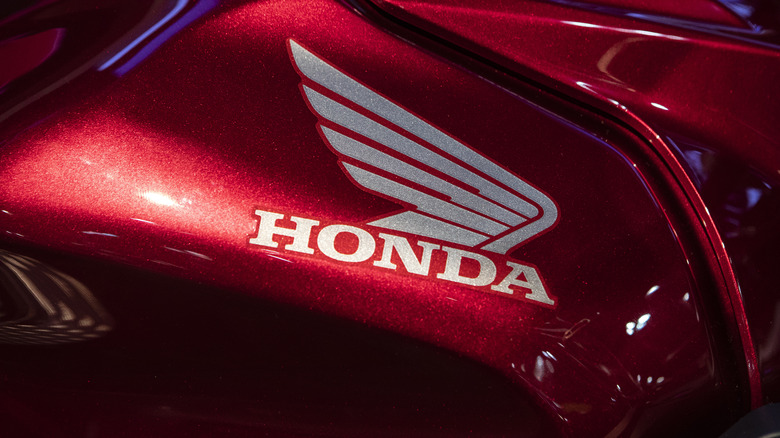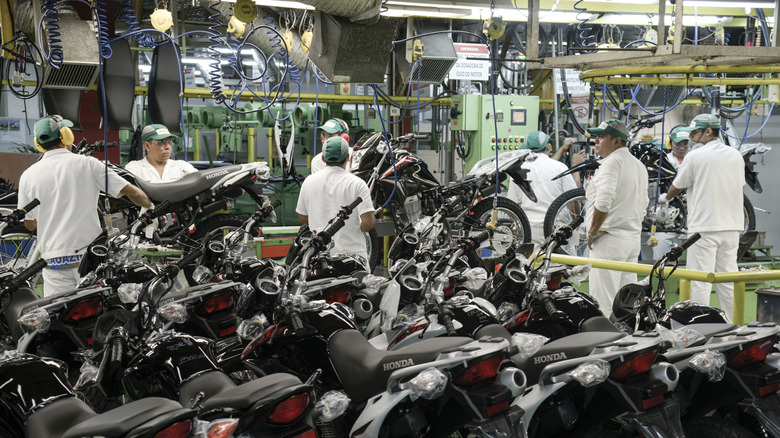Where Are Honda Motorcycle Engines Built & How Long Have They Been In Production?
These days, Honda is a global household name across a variety of industries, from lawnmowers to power generators and more. They're perhaps best known for making some pretty powerful cars with high horsepower engines, including the rare V8 Engine that once graced the Honda Crossroad (now only found commercially in a Honda Marine boat, the Honda BF350). Honda has consistently created reliable products that are known for innovation and quality. But while many people know Honda for its extensive car portfolio, it actually has a much longer history of producing motorcycles, including their engines.
In fact, Honda's winged logo, which was designed for its motorcycle arm, was established almost a decade before the version without it. Honda has released numerous successful motorcycles, such as the classic Honda Cub, the track legend Honda RC211V, and, of course, the pioneering superbike Honda CB750, which has one of the world's most reliable motorcycle engines. Whether it's beginner-friendly bikes for the timid first-timer or incredibly fast motorcycles designed for professionals on the track, there's a Honda motorcycle for every kind of rider.
To make this possible, Honda manufactures one core piece of technology that makes its motorcycles so special: the engine. If you're a fan of the Japanese manufacturer, you may be wondering how long it has been in the motorcycle game and if its latest models are still being made in the same facilities.
How long Honda Motorcycles have been in production?
In 1946, Honda's founder and namesake, Soichiro Honda, had the bright idea of adding engines to bicycles. At the time, Japan (and the rest of the world) was still reeling from the effects of World War II, which impacted a lot of resources in the country. Because of this, Honda made efforts to modify the already ubiquitous form of transportation, the bicycle, to be more efficient. A year later, the world was treated to Honda's first motorized bicycle, the A-Type, in 1947.
Debuting with a memorable teardrop-shaped aluminum fuel tank, it's important to note that the A-Type wasn't the most powerful motorcycle in the market at the time. However, it did trigger several other innovations that made it iconic, such as improvements in Honda's operations through die-casting and introducing the company's first conveyor line.
With only 34 employees and a dream, Honda began its decades-long journey to develop some pretty cool motorcycles like the old-school Honda RC166 250, the six-cylinder Honda CBX 1000, and the Honda CX500 Turbo. Honda's motorcycles even graced international action films, like a modified Honda CRF450X used in the Tom Cruise movie "Oblivion" and the Honda CM400 in Prince's "Purple Rain" film.
In the beginning, all of Honda's motorcycles were powered by engines manufactured in Japan. However, the efficiency of having a global supply chain was too good to pass up.
Where are Honda motorcycle engines built?
The push for being able to sustainably mass produce its motorcycles was always a priority for Honda. There are anecdotes from Honda's early days of the founder reminding his team that dealerships should be able to work independently from them. They needed to make it so that a worker with less skill could still perform assembly.
To maintain its 7 million unit production capacity, Honda has five small engine facilities in Europe, Thailand, China, Japan, and the United States. Some small engines, like the GS/GSV, are exclusively produced in the United States, while others, like the GC/GCV series, are made in the U.S. and Italy. Other engine models, like the GX Series, are produced in Japan, China, and Thailand. Aside from the GX series, the Kumamoto Factory in Japan makes the V-twin, M4(50cc+), and iGX.
With almost 50 years of history, the Kumamoto Factory is Honda's largest domestic factory in Japan. It produces several beloved motorcycles, like the Gold Wing, CB1300, GB350, the Super Club, and the Rebel 1100. Honda's China factory also manufactures the GXV160. Lastly, the manufacturing facility in Thailand also makes Honda's GXV series and the M4 (25/35cc).
In 2024, Honda remains profitable and continues to fulfill rising demands. On its Investor Relations page, Honda reveals that its motorcycle business generated an estimated $20.2 billion (or 2.9 trillion Yen) in revenue in 2023.


